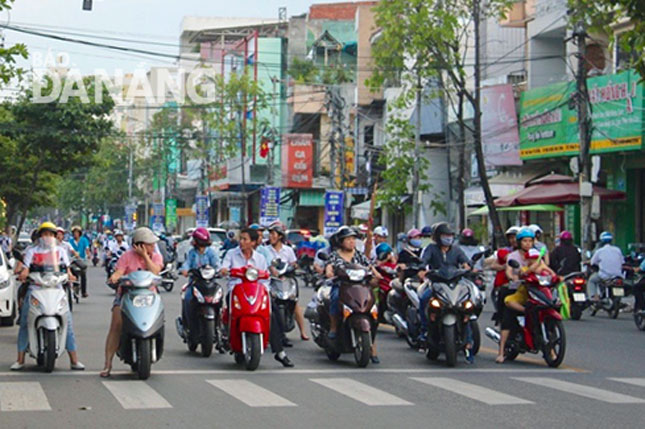Operation of smart city model for benefits of citizens and businesses
Whatever Da Nang is named- a smart, environmentally friendly or worth living city- its key goal is to deliver the maximum possible benefits for local residents and businesses.
 |
| The surveillance cameras system installed by CENTIC at the intersection of the Nui Thanh and Trung Nu Vuong streets is proving its efficiency in urban traffic management work (Photo: Khang Ninh) |
The statement was affirmed by Director of the Da Nang Department of Information and Communications Nguyen Quang Thanh during his recent interview with the DA NANG Newspaper.
Director Thanh said the smart city model is being developed on the basis of the e-government system which was officially put into operation in 2014, with the application of the ‘one-stop-shop’ mechanism, and software on managing government employees and administrative dossiers.
The smart city model is the next step in shifting the management-centred model into a government that acts to serve the people.
The smart city development requires the harmonious combination of information technology, infrastructure, policies, smart applications, and human resources with the intention of bringing the maximum possible benefits to the general public.
Since 2012 when the deployment of the smart city model started, Da Nang has effectively operated the e-government system, and successfully piloted many smart applications in various aspects.
Included are bus management, traffic control, surveillance camera, automatic water quality monitoring, environmental monitoring, food safety management, and open database systems.
The already-approved IT architecture framework for the smarty city project features 5 levels in total, namely connection, monitoring, storage, processing-analysis, and control and automation of some process management.
 |
| The e-government system is the firm foundation for the smart city development process. |
However, it is the fact that Da Nang is now facing some obstacles in reach its key target of becoming a truly smart city. Noticeable amongst them are certain issues relating the coordination with other localities, access to big smart solution providers worldwide, and security problems.
With regard to the city’s key partners in conducting the ongoing smart city development process, Da Nang is focusing on coordinating with many businesses of various sizes.
Importance is being attached to cooperating with the city’s key partners who are such domestic IT giants as Viettel, VNPT and FPT.
FPT eHospital, a comprehensive hospital management system, for instance, are being applied effectively in medical centres in Son Tra and Cam Le districts.
The system is trusted by 400+ big hospitals and clinics to manage all their activities from patient registration to discharge from the facility.
Automatic water environment monitoring stations, produced by the Da Nang Centre of Integrated Circuits (CENTIC) under the municipal Department of Information and Communications, are being put into operation in Da Nang.
Another business, the city-based Hekate Technology Co, joined forces with the local authorities to officially open Danang FantastiCity Chatbot, the first of its kind in Viet Nam.
As for local citizens’ involvement, they are being encouraged to join efforts with the city authorities in the smart city development process.
Accordingly, local residents can visit the website http://egov.danang.gov.vn/gop-y or switchboard 02361022 to submit their plans or solutions for a smart city design.
The aim of this website is to collect feedback on the city's services from the local community in urban, environmental, administrative and tourism-related services.
In the coming time, the city is aiming to develop a group of between 20 and 50 businesses active in the IT industry and the e-government system in order to attract their active engagement into the smart city development process.